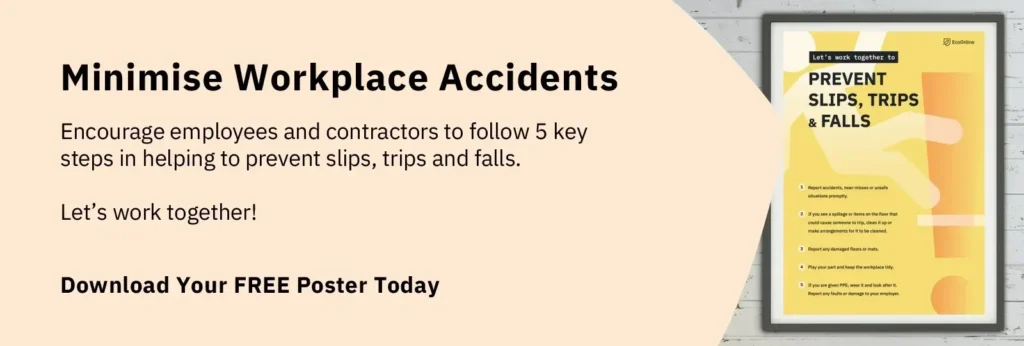
Ergonomic Hazards Meaning & Definition
What are ergonomic hazards?
An ergonomic hazard refers to any physical condition or factor found in the workplace that can cause injury or health hazards and concerns, both in the short and long term.
Many ergonomic hazards affect the musculoskeletal system causing aches or strains that may appear small and insignificant, to begin with, but can develop into serious ailments that can even cause permanent damage to the body.

Improve your workplace well-being
Empower your workforce against musculoskeletal challenges with our Free guide. Discover actionable tips and strategies for a healthier, injury-free workplace.
Improve your workplace well-being
Empower your workforce against musculoskeletal challenges with our Free guide. Discover actionable tips and strategies for a healthier, injury-free workplace.
Why is it important to take ergonomic hazards seriously?
It is important to take ergonomic hazards seriously in the workplace because what begins as a small muscle strain can eventually cause long-term health problems. If these hazards are not addressed, they can lead to injuries and illnesses that affect employees both physically and mentally.
What are the most common ergonomic injuries in the workplace?
Musculoskeletal disorders (MSDs) are a leading cause of illness and injury in the UK, with one in four of the general population thought to be suffering from some kind of musculoskeletal condition and 10.8 million lost working days as a consequence of each year.
The most common types of ergonomic injuries, under the wider MSD umbrella, include carpal tunnel syndrome (CTS), tendonitis, back pain, neck pain, and shoulder, wrist, or elbow injuries or strains.
These injuries can lead to long-term health problems if they aren’t treated properly, or prevented altogether, through proper ergonomics training programs for employees at all levels within an organization, or improved equipment and even style of work.
What does the law say about ergonomic hazards & musculoskeletal conditions?
The law surrounding ergonomic hazards and musculoskeletal conditions is complex, with responsibility falling on both the employer and the employee.
Employers are required to adhere to a host of safety guidelines relating to ergonomic hazards, while employees are required to take reasonable care of their own health and safety, and that of others affected by their work, but also to co-operate with their employer so they can comply with their health and safety duties.
More information relating to the legality surrounding ergonomic hazards can be found on the HSE website.
What are some common ergonomic hazards?
Ergonomic hazards can be found throughout any workplace but will often involve one, or a combination of the following:
- Poor posture/awkward postures
- Lifting heavy loads
- Strenuous tasks
- Slippery surfaces
- Repetitive tasks
- Poor quality chairs and workstations
- Awkward movements
Identifying Ergonomic Hazards
Equipment
In today’s often sedentary working style, many hazards are caused by equipment that comes with poor ergonomics. These can be badly designed chairs, keyboards, screens in an office, but also machines and tools used throughout the day that have not been ergonomically designed.
Ergonomics and the safety hazards they look to prevent have only really been in the public sphere of consciousness over the last twenty years or so, and consequently, older equipment will have most likely not been designed with ergonomics in mind.
Work environment
To get a sense of potential ergonomic hazards, take a close look at the work environment you are providing employees. What tasks are being repeated again and again, and in what position?
Jobs that require manual handling will unavoidably require plenty of movement, but what tasks involve continued repetition or persistent strain.
It also may well simply be that workers in an office are seated at a computer for 8 hours a day, a position that has been show to be profoundly unnatural for the human body.
Also, bear in mind where objects are kept in the workplace and whether everybody who needs to retrieve that can do so easily.
Psychological effects
It’s easy to assume that every ergonomic hazard involves muscles strains and bad backs, but that’s far from the case. While musculoskeletal injuries provide the bulk of the known, and obvious hazards, the psychological effects of poor ergonomics in the workplace can have dramatic effects.
Dull repetitive jobs, poor lighting, unhealthy work environments, and sustained poor posture are all hazards in the workplace that can lead to negative psychological effects.
We are only beginning to understand the complex psychological and physiological systems within the human body, but the effects of poor working environments on our psyche can be devastating.

How can ergonomic hazards be avoided?
While it’s often difficult to completely eliminate hazards in the workplace, there are several ways to mitigate their effects. These can be as simple as training sessions in how to lift loads correctly or as far-reaching as redesigning the workplace to address certain safety issues and reorganizing or restructuring how the work itself is carried out.
Administrative vs. engineering controls
Two different ways of reducing or eliminating safety hazards are administrative and engineering controls.
Engineering controls involve limiting risk and ergonomic hazards through direct physical means, such as:
- Reduce employee exertion with the aid of heavy lifting equipment
- Repositioning objects or redesigning workspaces to improve posture and create better working positions
- Make sure that a workspace has enough room to give employees the full range of motion needed to complete a set task
- Breaking tasks into smaller, more manageable sections
- Reducing weight loads where possible
Administrative controls involve altering work processes and activities to make them safer and reduce their impact on ergonomic injuries, such as:
- Labelling heavy loads with their correct weight
- Adjusting the pace at which employees are required to work at
- Provide sufficient breaks
- Storing objects in places that are both easily retrievable and don’t require excessive strain to reach
- Rotate employees who are working in repetitive or strenuous positions
Provide Training
While the effects of ergonomic hazards are becoming increasingly well known, we shouldn’t assume everybody understands the risks that come with a particular job.
Training, ideally by safety professionals, is an excellent way of raising understanding around ergonomic hazards and reducing their likelihood in the workplace.
Reimagining the workplace
It may be necessary to completely revolutionize your workspace. Standing desks, exercise balls, and even exercise chairs are just some of the ways that companies are looking to improve when it comes to ergonomics.
This will almost certainly involve some investment in the short term, but as we’ve seen, the costs of an ergonomic hazard left unresolved can have serious consequences both for the employee and the employer.
Improve your workplace well-being
Empower your workforce against musculoskeletal challenges with our Free guide. Discover actionable tips and strategies for a healthier, injury-free workplace.



